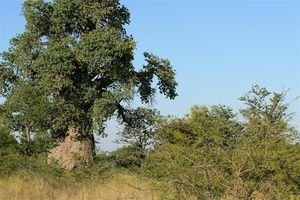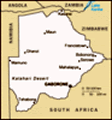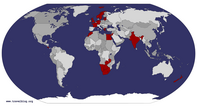Advertisement

 Baobab
Baobab
This particular baobab is rumoured to be approximately 4000 years old. To put that into context, at the time this tree was a seedling, workmen had just submitted the final invoice for the completion of Stonehenge.
The tree remains leafless for most of the year, giving the impression of having been planted upside down. Even stranger, it does produce flowers - but only at night.
They are very difficult to kill and the smooth bark is loved by elephants, who strip it away in order to get at the water inside. The tree simply grows more bark!
Interestingly, the tree stores water in its trunk and so apparently grows and shrinks throughout the year.I slept like a log and, like a log, I was covered in insects. I awoke at 06h15 and could see lots of the tiny critters all over my sheets and pillow. Worse still, my shoulders were covered in mosquito bites and I had bites in places I didn’t realise I had. Of course, like any gentleman, I’d used precautions, but no-one had bothered to tell the mosquitoes that they were supposed to stay
outside the net! I was not a happy bunny and quickly got up and stood under a hot shower in a vain effort to rid my rather handsome frame of all unwanted animal life.
Making a token effort at drying myself, I got dressed, grabbed a book and went and sat out in the early morning sun. Not having any luggage meant that I didn’t even possess a hair brush and letting my hair dry naturally in the sun gave me the Jimi Hendrix look but without the talent.
I watched the sun in its infancy climb up through the 4000 year old branches accompanied by the sound of the occasional vehicle passing by on the main road. Suitable counterpoint was provided by several cow

 Elephant Dining
Elephant Dining
We spotted this young bull standing by the side of the road, nonchalantly munching his way through the undergrowth. I don't believe there was too much traffic passing by but he certainly didn't seem bothered.
Apparently, he was usually to be found at that same spot, by the side of the road.bells and the intermittent bray of a donkey.
The sun was beginning to gain strength and as my hair was becoming more and more like a refugee from the 1970’s, I took the brave decision to go and flatten it with a licky-wash. Salvaging what pride I had in my appearance, I made my way to breakfast and joined Alfred, Jill and Brian in the dining area.
I use the word
breakfast in its loosest sense as there wasn’t a great deal that was appealing. Even the toast was rebellious and the coffee almost drinkable. Jill had also had trouble with the wildlife over night and admitted to being bitten in places that caused a gentleman such as me to blush.
With little else to do, eat or drink, we went back to our huts, packed our belongings and were on our way to Nata by 08h00!
Generally, the main roads in Botswana are pretty good. There’s relatively smooth tarmac and white lines down the centre of most roads and even road signs. But for some reason, the road between Gweta and Nata had escaped the attention of the local authority. I suspect that the proximity

 If you've got Big Ears, who's got Noddy?
If you've got Big Ears, who's got Noddy?
It was such a privilege to be so close to such a wild animal. Although these are highly intelligent beasts, we do tend to see them only this close when visiting the local zoo. To see this one in his habitat was so humbling.to the Makgadikgadi Pans had something to do with it. We’d been driving until this point at around 120kph but now were reduced to much slower speeds as we tried to avoid the worst of the potholes. As you can’t see the potholes until you’re in them, the trick is to watch for skid marks. Then you can slow to a crawl and drop into the pothole with all the aplomb of a pregnant ball bearing.
And so we continued the routine of accelerating, breaking hard, dropping, swearing and accelerating again until we reached Nata, which greeted us with a sign stating South Africa to the right and Zambia to the left. This was only slightly more useful than if the sign had said North to the left and South to the right.
Turning to the left, we headed north on smooth roads, towards Zambia. To our right, we espied a herd of elephant migrating from Chobe towards the Okavango. There were some thirty pachyderms, silently meandering towards the Delta, the smaller (younger?) ones in the centre.
A little later, we saw several giraffe in the distance also making the migratory journey but too far away to

 The Fish Eagle II (and our Sunset Cruise)
The Fish Eagle II (and our Sunset Cruise)
Our home from home for 3 hours as we sailed up and down the Chobe river seeking the best wildlife. Plenty was spotted, from hippo to kingfisher, from elephant to snake bird. The delightful and relaxing cruise was capped by the stunning sunset.photograph. This was my only sight of giraffe in the wild to date, although my Antipodean travelling companions had seen giraffe aplenty whilst in Namibia the week before.
As we continued, the sun began to reach its zenith and the vultures were riding the thermals in an attempt to spot an easy meal. We didn’t spot an easy meal but, with the recent elections in Zimbabwe and the non-announcement of the results, we were seeing long queues of lorries waiting to cross the border into Zambia as we arrived in Kasane. The queues caused us to drive on the wrong side of the road until we saw a lorry coming towards us, at which point we simply moved across and drove on the scrub.
Shortly thereafter, we arrived at the Chobe Safari Lodge and lunch.
Chobe - A Safari in a Box
The Chobe Safari Lodge is a very opulent building, with a wonderful history and reputedly the largest free standing thatched roof in the southern hemisphere. It was also on the tourist trail and full of American and British pensioners taking their last trip before Old Father Time confined them to a comfy chair in the

 Baby Monitor
Baby Monitor
Whilst my fellow travellers were taking photographs of a Monitor Lizard, I spotted this baby Monitor hiding at the end of a branch. Compared to the adult, this one is quite small.corner where they could dribble on their cardigans without offending anyone.
Ignoring this minor irritation, we made our way into the large, open air dining area and ordered lunch. Feeling very under-dressed in my grubby safari attire, I ordered a beer and a cheese toastie. Looking around, I could see that we were surrounded by wealthy pensioners in their newly acquired safari outfits, their thin white legs protruding beneath their crisp new shorts. To our right, the sound of spoilt children filled the air as they splashed their way through the swimming pool whilst their parents tried to look busy doing anything but quieten them down.
Lunch over, we headed off to our respective rooms with an instruction to be back by 15h00 for a sunset cruise. We had adjacent rooms, which were very well appointed with air conditioning and a remote controlled television. The walls were covered in photos from the colonial era and a patio door, warning that monkeys were thieves, opened onto a lawned area which dropped into the Chobe River. My attention was grabbed by a sign simply stating
Beware Crocodile. I resolved there and then, not to have a doze in the sun!

 Pied Kingfisher
Pied Kingfisher
This male kingfisher is one of the most common kingfishers to be found. It lives in burrows by open water and is the largest bird with the ability to hover. This means that it doesn't need nearby woodland in order to survive.After a quick wash, 15h00 neared and I joined Alfred and my travelling companions by the swimming pool as we waited for the Fish Eagle II to pick us up. As the boat arrived, so did a gaggle of tourists expecting to enjoy a cruise. They were most put out when we, in our grubby safari gear, were escorted through the throng and were greeted by the Chief Steward whilst they were told that the cruise was “full”. Making our way to the front of the boat and claiming our Director’s Chairs, it was soon clear that a “full” cruise comprised about 20-30 people - which gave us all plenty of space in which to move.
Having left our mooring, the first sight to greet us was that of a group of hippo, which were unfortunately too far away in the reeds to see in any great detail. We needn’t have worried though as, close to our port side, was an adult monitor lizard relaxing in the afternoon shade. Naturally, as it was our first sight, we all clambered to get a photo and it was then that I noticed a baby monitor on one of the branches.

 African Darter (Snake Bird)
African Darter (Snake Bird)
Although they feed mainly on fish, the Darter also eats snakes, frogs and other Crustacea by using its bill as a spear - hence the name "Darter". They also swim very low in the water with just their neck and head visible above the water giving the appearance of a snake - hence the common name of "Snake Bird".Rather fortuitously, this branch was extending over the water towards our boat making a photo even easier.
Further along the bank we spied a bee-eater and stopped to watch a pied kingfisher go about its business. As we went in search of the more traditional African wildlife, we also caught sight of a Snake Bird and, in the distance, a solitary elephant. We stayed just offshore as we watched it search beneath the sand, presumably for salt, scratching at the loose surface with its foot before using its trunk to scoop up the dirt.
Whilst our attention was on the elephant, a commotion broke out at the front of the boat; someone had spotted a crocodile. This beauty didn’t look as though it was very agile, but I suspect that its victims weren’t given the option of a second opinion. Close to this gargantuan beast was a smaller reptile, also not apt to allow second opinions.
Continuing our cruise, we soon came across a bloat of some twenty hippo resting in the water, their funny little ears twitching in a vain attempt to flick off annoying insects. They seemed thoroughly at home with their ears, eyes and

 The Almost Invisible Crocodile
The Almost Invisible Crocodile
Despite its size, we almost missed this chap, his dappled skin echoing the shadows cast by the leaves on the trees.nostrils on the water line, occasionally lifting their heads to reveal an apparent big smile!
After spending some time with these aquatic animals, our attention once again returned to the shoreline where five youngish elephants were playing in the sand, running up and down and generally letting off steam. After a while, more elephants emerged from the bushes and closer inspection revealed not one, but two calves. These were so cute running in and out of the water and falling into holes. The whole boat was in awe of these majestic animals and the chance to witness their lives at such close quarters.
Further sightings of Fish Eagle, Kudu, Hippo and Giraffe were made and, as the sun began to sink, we slowly made our way back to the lodge, reminiscing about the animals we’d just seen, especially the privilege of viewing such a young elephant in its natural environment. Oh - as it was a sunset cruise, we also ensured we captured the sunset for posterity!
Banks and Blogs
With the end of the safari just a few days away, I was becoming concerned that my small amount of clothing was also coming to an end.

 Baby Crocodile
Baby Crocodile
Yes, this really is a baby. I can vouch for that as there was an adult not too far away that was several sizes bigger!My straw hat, which was over 13 years old and had been all around the world with me had certainly seen better days. My carrier bag was also showing signs of wear. So, after a shower, it was off to the ATM at the “shopping centre” next door to withdraw some hard earned cash.
Wandering across the car park and through the Botswanan troops, I made it to a Barclays cash machine - only to find that it didn’t take international cash cards. Not being disillusioned, I headed to Botswana’s first portable bank (yes, seriously) where the First National Bank ATM also didn’t take international cash cards! Now I was disillusioned and headed back to the safari lodge and persuaded the gift shop to charge my new shirt to my room.
Meeting up with my companions for tea, we ordered a bottle of South African Chenin Blanc and joined the other holiday makers at the buffet, where I satisfied my craving for more meat by having lamb, impala and kudu steaks.
Relaxing later in the bar with a bottle or three of St. Louis, I made a few notes for my travel blog and sat by the

 A Bloat of Hippos
A Bloat of Hippos
The River Horse can weigh up to 3 tons and spends its time eating plants and soaking in the water. Despite its weight, these animals can move extremely fast both in water and on land - much faster than you or I can run!Chobe River watching the stars and listening to the frogs’ chorus before making my way to bed.
Advertisement
Tot: 0.23s; Tpl: 0.016s; cc: 7; qc: 25; dbt: 0.1616s; 1; m:domysql w:travelblog (10.17.0.13); sld: 1;
; mem: 1.1mb


















Brian Cosgrove
non-member comment
very helpful
I photograghed two the Oriental Darter and the African Darter I had trouble believing that they were both Darters as they were both generalised as Darters. If interested Iwill forward photos Rgds Brian